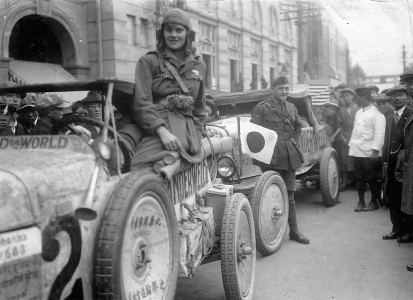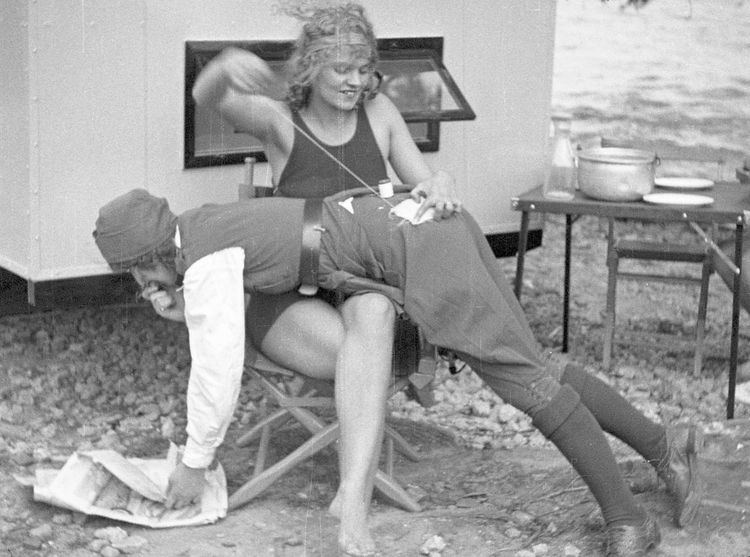Nationality American/Canadian Other names Aloha W Baker | Name Aloha Wanderwell | |
 | ||
Full Name Idris Galcia Hall Occupation World traveller, filmmaker, explorer, lecturer Known for First woman to circle the world in an automobile, starting at 16 Spouse(s) Walter Wanderwell (m. 1925)Walter Baker (m. 1933) Children Valerie (b. 1925)Nile (b. 1927) Died 1996, Newport Beach, California, United States | ||
Aloha wanderwell s driving passion sample reel
Aloha Wanderwell (born Idris Welsh; adopted name Idris Glacia Hall 13 October 1906 – 4 June 1996) was a Canadian-American internationalist, explorer, author and filmmaker and aviatrix, born in Canada. While still a teenager, she joined an expedition to travel across the world by Ford 1918 Model T, 1930 Model A, and 1935 Touring Sedan, all Fords. Aloha began her adventuring career when she met her traveling companion, Walter "Cap" Wanderwell, in 1922. They married in 1925 and had two children as they continued to travel the world, Aloha performed on stage doing travel lectures while next to her, a silent movie "Car and Camera Around the World", played. The Wanderwells recorded their world journeys on 35mm nitrate and 16mm film, which all reside in the vaults at The Academy Film Archives, Hollywood, California USA. While stranded in Brazil, she lived among the Bororo people and recorded the earliest film documentation of them for 6 weeks. In 1932, her husband was shot and killed on his yacht Carma in Long Beach, California. Aloha later married Walter Baker and continued her travels, ultimately visiting over 80 countries and six continents, and driving over 500,000 miles all in Fords.
Contents
- Aloha wanderwell s driving passion sample reel
- Rare 1920s and 1930s footage from aloha wanderwell baker
- Early life
- The Wanderwell Expedition
- Brazil
- Murder of Walter Wanderwell
- Life with Baker
- Archives
- Filmography
- References
"First Female to Drive Around the World" 1922-1927 Guinness World Records.

The first female to drive around the world was achieved by Aloha Wanderwell (USA/Canada) who traveled the world in a Ford Model T, starting and ending in Nice, France, between 29 December 1922 and January 1927. Aloha traveled as driver, translator and film maker for the Wanderwell Expeditions, a round-the-world motoring tour led by Walter "Cap" Wanderwell (Poland).

Rare 1920s and 1930s footage from aloha wanderwell baker
Early life
Idris Galcia Welsh was born on 13 October 1906 in Winnipeg, Manitoba to Margaret Headley and Robert Welsh. In 1909, her mother married Herbert Hall, and her name was changed to Idris Hall. Her step-father was a developer and rancher on Vancouver Island and the family lived in Parksville and Duncan. In 1914, at the start of the First World War, her step-father joined the Canadian Expeditionary Force and after arriving in England was transferred to the British Army and made a lieutenant in the Durham Light Infantry. The family (Idris, her sister Margret "Miki" Hall, and their mother) followed him to Europe, where they traveled around England, Belgium, and France. In June 1917, Herbert Hall was killed in combat in Ypres, Belgium.
Hoping to tame Idris's tomboyish tendencies, her mother sent her to boarding schools, first to Benedictine Soeurs du Saint-Sacrement in Courtrai, Belgium, later to Chateau Neuf in Nice.
The Wanderwell Expedition
In 1921, Walter Wanderwell was capturing headlines with the Million Dollar Wager, a round-the-world endurance race between two teams racing Ford Model Ts to see which team could visit the most countries. A controversial figure, Wanderwell (born Valerian Johannes Pieczynski) had been jailed in the United States during World War I on suspicion of being a German spy, but was released in 1918. Wanderwell was inspired by his meeting with the League of Nations and around 1930 he formed his own organization Work Around the World Educational Club or (WAWEC).
In 1922, when she was 16, Idris met Walter Wanderwell for the first time, after responding to one of his advertisements declaring "Brains, Beauty & Breeches – World Tour Offer For Lucky Young Woman…. Wanted to join an expedition… Asia, Africa…" She met with "Captain" Wanderwell in Paris and secured a seat on the expedition. She served as the expedition's translator, driver and secretary, and took on the name "Aloha Wanderwell," even though Walter was still married to Nell at the time, but divorced after Aloha joined the expedition.
Partially sponsored by the Ford Motor Company, the round-the-world tour also sustained itself through filming and travel lectures, from Africa through the Middle East and on to Asia. In Calcutta in 1924, their tour crossed paths with planes from the first aerial circumnavigation, and Aloha filmed their meeting.
They came to the United States in January 1925. Aloha would become an American citizen and marry Wanderwell on April 7, 1925 in Riverside, California. Their marriage foiled a plan by FBI agents to arrest Pieczynski under the Mann Act, a law that prohibits transporting women across state lines for "immoral purposes."
Aloha gave birth to a daughter, Valri, in December, 1925 and son Nile in April, 1927. The Wanderwells continued their travels, sailing to Cuba and South Africa. Aside from dealing with poor roads, the Wanderwells also had difficulty finding gasoline for their vehicles. During their travels through Africa from 1926-1928, they used crushed bananas for grease and elephant fat for engine oil. The global tour included 43 countries. Author Stookie Allen contends that during this time, Hall cut her hair and fought as a member of the French Foreign Legion.
The Wanderwells returned to the United States where they made a home in Miami in 1929 and donated one of their Model Ts, known as Little Lizzie, to Henry Ford before the screening of the film, Car and Camera Around the World. In 1942, Henry Ford decided that Little Lizzie and 50 other autos would be scrapped for the war effort.
Brazil
In 1930 and 1931, Aloha learned to fly a German seaplane, "Junker" that she would later land on an uncharted part of the Amazon River when the Wanderwells traveled to the state of Mato Grosso in Brazil. They set up camp at the Descalvados Ranch in Cuiabá and were ostensibly searching for lost explorer Colonel Percival Harrison Fawcett, who was looking for the legendary Lost City of Z (some speculate this to either be synonymous or different to the legendary city of Eldorado). They made several flights with a seaplane, once running out of fuel on the Paraguay River and receiving help from the Bororo people. The crew's cameraman filmed a ceremonial dance, a first contact scenario with Boboré villagers, and Bororo men experiencing sympathetic labor pains. The 32-minute silent film called Last of the Bororos is preserved in the Smithsonian Institution's Human Studies Film Archives and includes Aloha's meeting with Brazilian explorer Cândido Rondon.
Murder of Walter Wanderwell
In late 1932, the couple purchased a yacht, the 110-foot Carma, intending to document their voyage to the South Seas on film. On December 5, 1932, the day before they were to embark, Walter Wanderwell was murdered on the yacht in the harbor near Long Beach, California. William James Guy, a member of their 1931 expedition to South America who had attempted to mutiny on a previous voyage, was tried for the crime. Guy had an alibi and was acquitted by the jury and Judge Kenny. Another man, Edward Eugene Fernando Montague, was briefly considered a suspect, but was never charged.
Life with Baker
Aloha later married Walter Baker in Louisiana The couple traveled to New Zealand, Australia, India, Cambodia, Wyoming USA & Indochina, with Aloha later recounting being surrounded by five herds of elephants and having to shoot their way out. Her final films include To See the World by Car (1935–37), India Now, and Explorers of the Purple Sage, in Tecnicolor, which contains the only known footage of Desert Dust, the famous palomino wild horse. All films were made with Walter Baker.
She continued to give lectures and wrote an autobiographical account of her travels, Call to Adventure!, published in 1939, and later republished in 2012. The couple eventually settled in Cincinnati, Ohio where Wanderwell worked in radio broadcasting, WlW Radio 1939, and print journalism. In 1947, she and Walter Baker moved to Lido Isle community in Newport Beach, California. Aloha gave her final performance in front of 150 family members and guests, with Dr. Pete Lee, curator at the Natural History Museum in Los Angeles in 1982. She died on June 4, 1996.
Archives
Footage by Aloha Wanderwell is held at the Academy Film Archive in the Aloha Wanderwell Baker Film Collection. The Academy Film Archive has preserved approx. 60 cans of film 35mm and 16mm, including rare 1920s and 1930s footage.
